Cornering basics 1 - assessing the bend (limit point)
Discussion
This is the first in a series of articles on cornering, and to make it easier to understand, I've been out and taken some photographs. I only hope that I manage to post them properly, otherwise this will make as much sense as quantum mechanics if the pictures don't come out.
Anyway, for the first couple of parts in this series, I've decided to look at something else that is considered a bit of a "black art" - assessing the severity of bends. There's not really any secret to it, but I've heard some ruddy complicated explanations in the past, so it's not surprising that some people think it involves voodoo. I'll try to stick to my mantra of KISS - Keep It Simple, Stupid - and you'll probably find that, actually, it's quite straightforward and that you probably use a lot of these skills already.
THE LIMIT POINT
Let's deal with this little chestnut to start with, as it's the one that most people struggle to get their heads round. Have a look at this picture of a section of road - you can see a straight piece of road over a motorway bridge, followed by a left-hand bend in the distance...
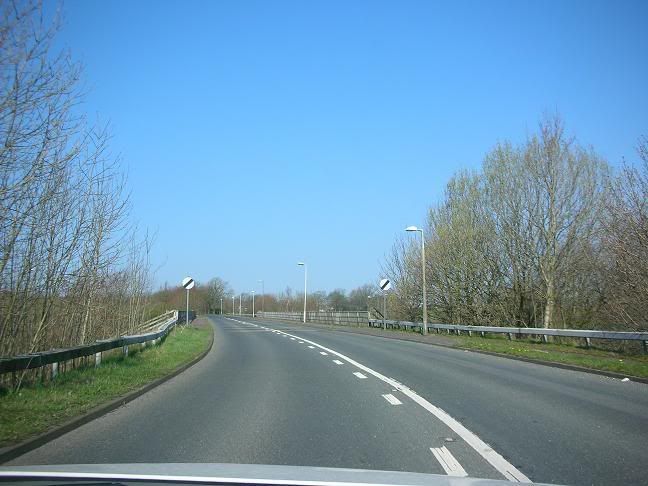
Now, there's plenty to look at - it's obvious we're coming off a left-hand bend with double white lines, there are some NSL signs, the road goes over a bridge, there are some street lights on the offside, some rumble-strips which are, presumably for traffic travelling towards us, a change from double white to hazard lines, and, right in the distance, you can see the limit point for the left-hand bend.
What? Oh, sorry - I didn't explain - the limit point has been described to me as "the furthest point at which you have an uninterrupted view of the road surface", which sounds a little pompous, and "The point at which the nearside and offside verges seem to meet", which is a bit better, but the opposite verges of a road don't actually meet, do they? That'd be silly. A better description would be "The furthest point you can see the road surface" - less pompous I think, and straight to the point. Straight to the limit point, in fact.
For the next few pictures, however, I've recruited an assistant in the form of the hand of God, who will point out the limit point for you (Obviously, in these politically correct days, it doesn't have to be the hand of God - insert "Allah", "Brahman", "Ishvara", "Vahiguru", "Senna" or whatever else takes your fancy).
Anyway, here's the same picture again, with the limit point indicated...
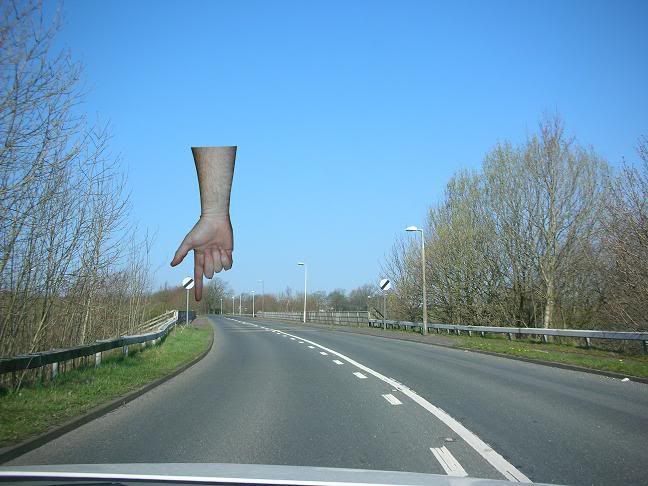
As you can see, the limit point is waaay in the distance, but although the driver may be performing other actions at this point on the road, such as changing to a flexible gear, checking the mirror and preparing to accelerate, they'll be paying some attention to that limit point, as it will help them to determine the severity of the next bend, and assist them in mentally preparing a plan as to how to drive through the corner.
The thing to look for with a limit point is it's relative position to you as you approach. If you seem to be getting closer to it as you approach the bend, then the bend will be quite tight. If it seems to be remaining a constant distance from you, as, for instance, a rainbow does as you move towards it, then the bend isn't getting any tighter. If the limit point seems to be going further away, then the bend is opening up and the road is straightening.
Lets recruit Gods help again, and look at where the limit point is after we've moved a short distance up the road...
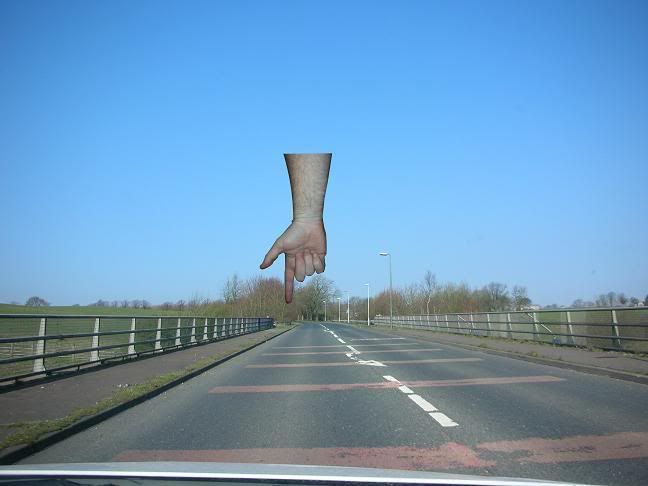
Right - we've moved forwards onto the bridge now, the driver will be accelerating at this point, and their focus will be towards the corner. Look left from the bend, across the adjacent fields, to see if there is a view of the road, as this can assist in assessing how tight it is. In this case, there isn't a view to the left, so we're relying on the limit point to show how tight it is. With help from the hand of God, you can see that we appear to be getting closer to it.
Let's move a bit further forward...
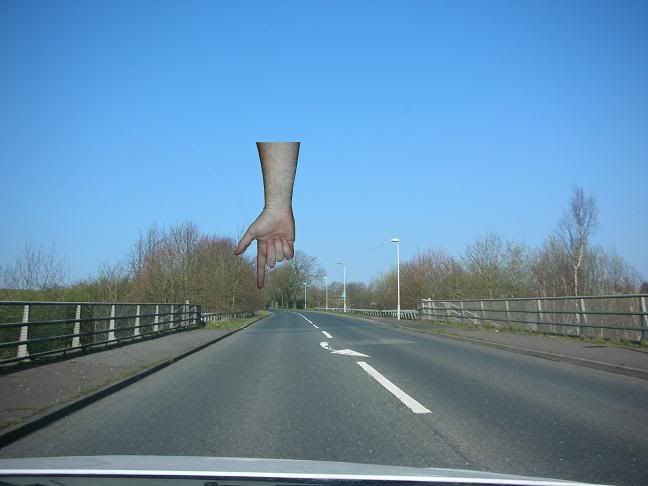
We're halfway across the bridge now and we're still getting closer to the limit point. There are some other clues as to how tight the bend is though, and they're in the form of what you can't see, more than what you can see.
You can't see a triangle warning sign for the bend, you can't see a chevron board to the left, you can't see a change back to double white lines and you can't see a "SLOW" painted on the road. The fact that you can't see these things is an indicator that the bend won't be particularly tight.
One other thing - take notice how many lamp-posts you can see to the right in this picture, as it'll give you a guide to how far forward I'm moving, and what the limit point is doing. In the above picture, you can see four lamp-posts.
Let's move on again - God, it's over to you...
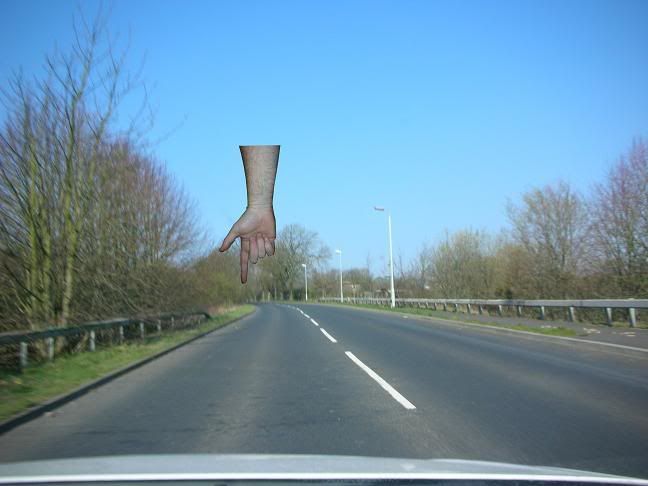
From this one, you can see that I've moved forward by one lamp-post, and now the limit point has started moving forwards too. This is a critical point, as, when you're driving through this bend, the limit point is now acting like a rainbow, and moving away at the same rate as we're driving towards it. As we're still a distance away from the bend, this means that it's going to be a quite open corner, so we're unlikely to have to lose much, if any speed to negotiate it.
On to the next one...
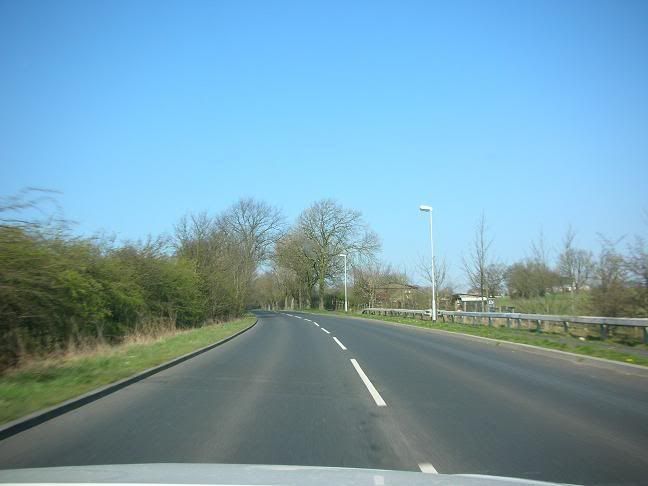
Well, we've only moved forward another lamp-post, but things have changed quite dramatically on the limit-point front. So dramatically, in fact, that in that short distance, the limit point has shot off away from us, and no longer exists, so we've nothing for the hand of God to point at any more. Look at where we are on the road - we're only just entering the bend, and yet the limit point has gone completely, and we can quite happily accelerate through the corner.
Obviously, it's very easy from that position to see that the corner is nice and open, but if you've paid attention to the limit point from when it first becomes visible, then you can work out how open or tight the bend is from much further back, which obviously helps you to make your all-important driving plans.
There are many more ways of assessing the severity of corners, and I'll look at them next time.
Anyway, for the first couple of parts in this series, I've decided to look at something else that is considered a bit of a "black art" - assessing the severity of bends. There's not really any secret to it, but I've heard some ruddy complicated explanations in the past, so it's not surprising that some people think it involves voodoo. I'll try to stick to my mantra of KISS - Keep It Simple, Stupid - and you'll probably find that, actually, it's quite straightforward and that you probably use a lot of these skills already.
THE LIMIT POINT
Let's deal with this little chestnut to start with, as it's the one that most people struggle to get their heads round. Have a look at this picture of a section of road - you can see a straight piece of road over a motorway bridge, followed by a left-hand bend in the distance...

Now, there's plenty to look at - it's obvious we're coming off a left-hand bend with double white lines, there are some NSL signs, the road goes over a bridge, there are some street lights on the offside, some rumble-strips which are, presumably for traffic travelling towards us, a change from double white to hazard lines, and, right in the distance, you can see the limit point for the left-hand bend.
What? Oh, sorry - I didn't explain - the limit point has been described to me as "the furthest point at which you have an uninterrupted view of the road surface", which sounds a little pompous, and "The point at which the nearside and offside verges seem to meet", which is a bit better, but the opposite verges of a road don't actually meet, do they? That'd be silly. A better description would be "The furthest point you can see the road surface" - less pompous I think, and straight to the point. Straight to the limit point, in fact.
For the next few pictures, however, I've recruited an assistant in the form of the hand of God, who will point out the limit point for you (Obviously, in these politically correct days, it doesn't have to be the hand of God - insert "Allah", "Brahman", "Ishvara", "Vahiguru", "Senna" or whatever else takes your fancy).
Anyway, here's the same picture again, with the limit point indicated...

As you can see, the limit point is waaay in the distance, but although the driver may be performing other actions at this point on the road, such as changing to a flexible gear, checking the mirror and preparing to accelerate, they'll be paying some attention to that limit point, as it will help them to determine the severity of the next bend, and assist them in mentally preparing a plan as to how to drive through the corner.
The thing to look for with a limit point is it's relative position to you as you approach. If you seem to be getting closer to it as you approach the bend, then the bend will be quite tight. If it seems to be remaining a constant distance from you, as, for instance, a rainbow does as you move towards it, then the bend isn't getting any tighter. If the limit point seems to be going further away, then the bend is opening up and the road is straightening.
Lets recruit Gods help again, and look at where the limit point is after we've moved a short distance up the road...

Right - we've moved forwards onto the bridge now, the driver will be accelerating at this point, and their focus will be towards the corner. Look left from the bend, across the adjacent fields, to see if there is a view of the road, as this can assist in assessing how tight it is. In this case, there isn't a view to the left, so we're relying on the limit point to show how tight it is. With help from the hand of God, you can see that we appear to be getting closer to it.
Let's move a bit further forward...

We're halfway across the bridge now and we're still getting closer to the limit point. There are some other clues as to how tight the bend is though, and they're in the form of what you can't see, more than what you can see.
You can't see a triangle warning sign for the bend, you can't see a chevron board to the left, you can't see a change back to double white lines and you can't see a "SLOW" painted on the road. The fact that you can't see these things is an indicator that the bend won't be particularly tight.
One other thing - take notice how many lamp-posts you can see to the right in this picture, as it'll give you a guide to how far forward I'm moving, and what the limit point is doing. In the above picture, you can see four lamp-posts.
Let's move on again - God, it's over to you...

From this one, you can see that I've moved forward by one lamp-post, and now the limit point has started moving forwards too. This is a critical point, as, when you're driving through this bend, the limit point is now acting like a rainbow, and moving away at the same rate as we're driving towards it. As we're still a distance away from the bend, this means that it's going to be a quite open corner, so we're unlikely to have to lose much, if any speed to negotiate it.
On to the next one...

Well, we've only moved forward another lamp-post, but things have changed quite dramatically on the limit-point front. So dramatically, in fact, that in that short distance, the limit point has shot off away from us, and no longer exists, so we've nothing for the hand of God to point at any more. Look at where we are on the road - we're only just entering the bend, and yet the limit point has gone completely, and we can quite happily accelerate through the corner.
Obviously, it's very easy from that position to see that the corner is nice and open, but if you've paid attention to the limit point from when it first becomes visible, then you can work out how open or tight the bend is from much further back, which obviously helps you to make your all-important driving plans.
There are many more ways of assessing the severity of corners, and I'll look at them next time.
Edited by R_U_LOCAL on Sunday 1st April 23:06
BliarOut said:
7db said:
BliarOut said:
Look at the treeline in piccie 3.... They're following a feature of some sort which is more than likely the road. Although more information becomes available as you continually "read the book" you have an early clue that it's probably a sweeping left hander.
I reckon it curves right round the village and past the church before heading out again and up the hill.
I reckon you know where the road is

I don't reckon he does.

All will be revealed in the next installment.
Gassing Station | Advanced Driving | Top of Page | What's New | My Stuff



